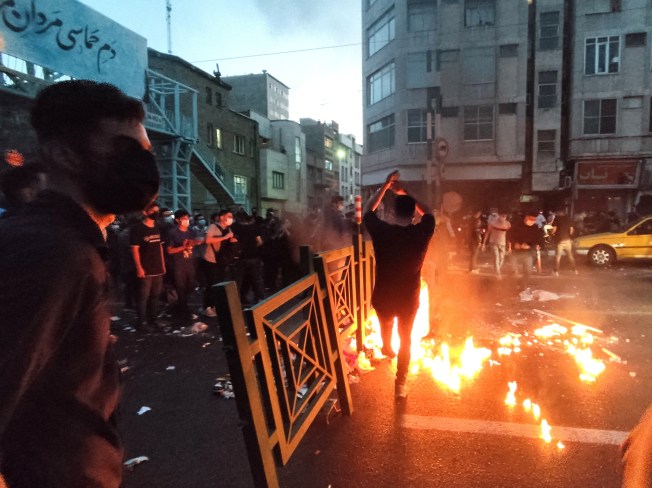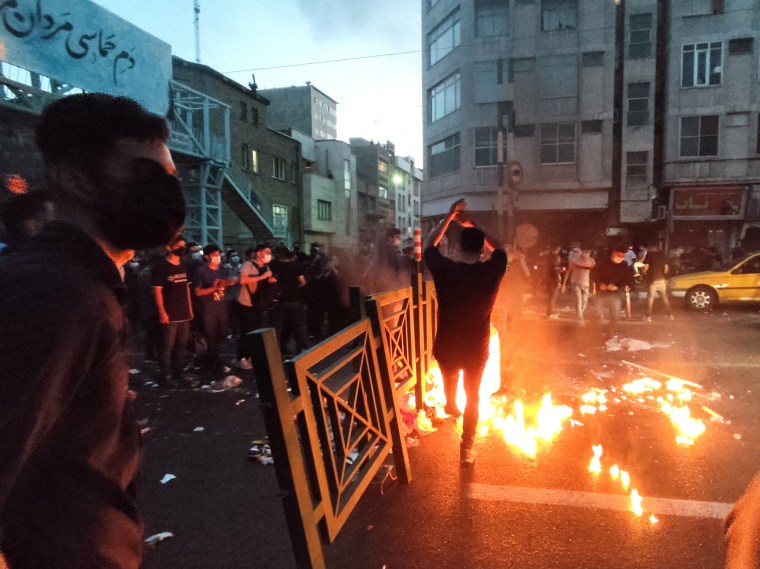Mass protests and arrests in Iran: a Q&A with Yeganeh Rezaian, CPJ’s Senior Researcher

When mass protests erupted in Iran more than two weeks ago, the government cracked down hard. As clashes between security forces and demonstrators left many dead and disruptions to internet service made information hard to obtain, CPJ learned that security forces had arrested at least 28 journalists as of September 29. CPJ senior researcher Yeganeh Rezaian, who spent more than two months in solitary confinement while an accredited journalist in Iran, spoke with Insider to discuss the implications of the latest developments.
What do we know about the protests and the journalists reporting on them?
The protests have been happening daily for two weeks. They’re happening in dozens of cities large and small, including the two main religious centers: Mashhad and Qom.
As we’ve seen regularly in recent years, Iranians are dissatisfied with the ruling Islamic Republic and have risen up against its abuses of power. In this case, it was the death of a 22-year-old woman named Mahsa Amini while in morality police custody for allegedly not wearing her hijab properly, according to officials. That incident set off the most significant protests in the system’s 43-year history–that must be said is women-led–and they show no signs of slowing.
Since the unrest began, CPJ has learned of new journalist arrests every day. By September 29, we had confirmed that at least 28 journalists had been arrested, many violently, usually after midnight. And the Norway-based NGO Iran Human Rights estimates that at least 76 protesters have been killed thus far, but many observers believe the number could be much higher.
One source who spoke to us from HaftHoz square in the eastern part of Tehran said the arrests and crackdowns are brutal, with people being arrested simply for being in the street, regardless of what they wear. “You could easily feel the heavy presence of anti-riot police throughout the city,” the source said. “Also, protests have shifted from daylight, when the morality police usually patrol, to nighttime hours so protesters can better obscure their identities.”
Others have told us that the nature of the protests is changing, with many protesters coming out in their cars instead of on foot to reduce their chances of arrest.
How do the arrests of journalists affect coverage of the protests?
Security forces create an environment of fear in neighborhoods when they raid journalists’ homes, scaring families and neighbors away to make sure no one reports the arrests or talks to the media, especially the Persian-language media in exile. And then journalists are usually taken to solitary confinement in the notorious Evin prison or, in some cases, held in very crowded and unsanitary cells, or with low-quality food in the all-women Qarchak prison.
Additionally, the government does not want reporting about these protests to reach the outside world, so they have greatly restricted internet access and at times have shut it off entirely. That has made it difficult both to share images about protests taking part in different parts of the country and also for ordinary citizens to communicate with the world beyond its borders.
It’s worth noting that in an interview broadcast on Iran’s state television network, President Ebrahim Raisi blamed the protests on the United States, saying it wanted “to create chaos and jeopardize security in this country.” The Islamic Republic has often used such accusations of foreign collaboration as a justification for the mass arrest and harsh treatment of protesters. Some lawmakers are already calling for demonstrators to be executed.
The U.S. has adjusted its sanctions on Iran so tech companies can give Iranians access to more services and platforms. Do you expect that to help in getting more information about what’s happening?
The effects of the U.S. move will likely not be felt immediately. Observers note that while the internet has not been shut down completely in some parts of the country, download speeds have been reduced to a trickle.
Many of the Iranian journalists arrested are women, and veteran journalist Christiane Amanpour, a senior adviser to CPJ’s board of directors, made headlines last week by refusing to wear a headscarf to an interview with Iranian President Ebrahim Raisi. What difficulties are women journalists facing as they try to cover this moment in Iran?
Women journalists have always faced challenges in Iran. I know this all too well, having been imprisoned and held in solitary confinement for (more than two months) while I was an accredited journalist in Iran. By law, we are degraded, so gender-based attacks on women generally go unpunished and, in some cases, are even encouraged by authorities.
Iranian Twitter is a particularly nasty place for women journalists, as we’ve documented before. It’s a very stifling environment to work in, but female journalists, like other women in society, have been undeterred by the threats of reprisal from authorities. It’s one of the reasons that this moment feels different.
What is CPJ doing to help, and what can our advocates and supporters do to help?
CPJ is tracking developments closely and watching the rise in the number of journalists arrested with great concern. We will continue to call for their immediate and unconditional freedom but also work with partner organizations to support Iranian journalists in trouble.
In recent years, we have secured safe passage for several exiled Iranian journalists at risk of deportation back to Iran, where they would face potentially horrific fates. We expect the number of such cases to rise dramatically in the coming weeks and months. We already started getting various forms of assistance requests from Iranian journalists.
CPJ holds a discussion with Nobel laureate Maria Ressa and her lawyer Amal Clooney at the Knight Foundation Press Freedom Center

CPJ recently welcomed to our New York offices, at the John S. and James L. Knight Foundation Press Freedom Center, Nobel laureate and persecuted journalist Maria Ressa, alongside barrister Amal Clooney, who co-leads the international legal counsel team defending Ressa.
Ressa and Clooney, both previously honored with CPJ’s Gwen Ifill Press Freedom Award, spoke with CPJ President Jodie Ginsberg in a conversation exploring the criminalization of journalism and the ongoing legal harassment against Ressa and her news website, Rappler.
Check out our short video to hear some of the discussion:
CPJ participates in UNGA week

This month, the U.N. General Assembly week in New York served to gather legal experts, diplomats, and activists. CPJ used the opportunity to discuss the plight of journalists forced to flee their homes and the responsibility of governments to provide safe refuge through special emergency visas. During a high-level side-event hosted by the Czech Republic, CPJ President Jodie Ginsberg joined Czech Foreign Minister Jan Lipavsky and deputy chairs of the High Level Panel of Legal Experts on Media Freedom to make a case for these visas. CPJ has advocated for such visas in the past in line with recommendations for members of the Media Freedom Coalition, a group of 52 governments that support press freedom.
Ginsberg’s message: Governments must create special emergency visas for journalists to allow them to evacuate and relocate to safety quickly. The visas should be granted to individuals at risk due to their work keeping the public informed. As Ginsberg noted, across the world, from Afghanistan to Nicaragua and Belarus to Myanmar, CPJ has worked on hundreds of cases of such journalists seeking safe refuge. There is no time to waste.
Journalists forced to flee often try to continue reporting in exile. Panelist Roman Anin, an exiled investigative journalist who runs the news website iStories, shared his story of moving his newsroom out of Russia. “When the war started, we had a choice between three options, either stay in Russia and stop our work, stay in Russia, continue our work and end up in jail, or relocate the newsroom,” he said. Anin said that despite the hardship of the relocation, his newsroom has been able to reach Russian audiences with stories on alleged war crimes committed in Ukraine.
Anin’s experience, and CPJ’s own work helping displaced journalists, demonstrate how critical it is for governments to prioritize emergency visas for swift relocation and safety. Refusing to do so not only impacts the lives of individual journalists but it is also a blow to free expression and access to information globally.
Must-reads
CPJ spoke with press freedom groups in Spain about concerns that promises of government reforms to a “gag law,” which has been a tool for “camouflaged censorship” of the press, would not be met. “Freedom of the press is a fundamental right that can only be limited on an exceptional basis,” one press freedom group told CPJ, “These clauses have been used to disproportionately and arbitrarily prevent journalists from informing the public.”
CPJ is looking into why the Indian government is imposing travel bans on Kashmiri journalists–and whether there might be a legal path to challenging the bans in court after Indian journalist Rana Ayyub successfully challenged a ban to travel to London in March. The bans increase self-censorship and cause psychological trauma. Raqib Hameed Naik, a Kashmiri journalist, living in exile in the United States, called the bans “inhumane, and a constant reminder that Kashmiri journalists live in an open-air prison.“
Four years have passed since Washington Post columnist and Saudi journalist Jamal Khashoggi was murdered and dismembered at the direction of Saudi Crown Prince Mohammed bin Salman. CPJ continues to demand accountability in the journalist’s murder. “The U.S. response to Khashoggi’s death will always stain the record of President Joe Biden’s professed support for press freedom and human rights worldwide,” said CPJ’s Middle East and North Africa Program Coordinator Sherif Mansour.
CPJ in the news
“‘People’s Tribunal’ seeks justice over journalist killings,” The Associated Press
“Iran targets journalists covering country’s sprawling unrest,” Bloomberg
“Pakistan’s foreign minister talks about the country’s flood damage,” NPR
“In journalism world, killing of RJ reporter viewed as ‘an exceptional case’,” The Las Vegas Review-Journal
“Journalist’s ‘treason’ case raises new concerns over Russian dissent crackdown,” Axios
“Egypt charges Mada Masr editor, journalists with spreading false news,” Arab News
“Press freedom under threat again for whistleblowers,” Independent Australia
“Egypt frees Al Jazeera journalist Ahmed al-Najdi,” Al-Jazeera
“Mexico wants the U.S. to hand over El Chapo’s godson for killing of legendary journalist,” VICE
